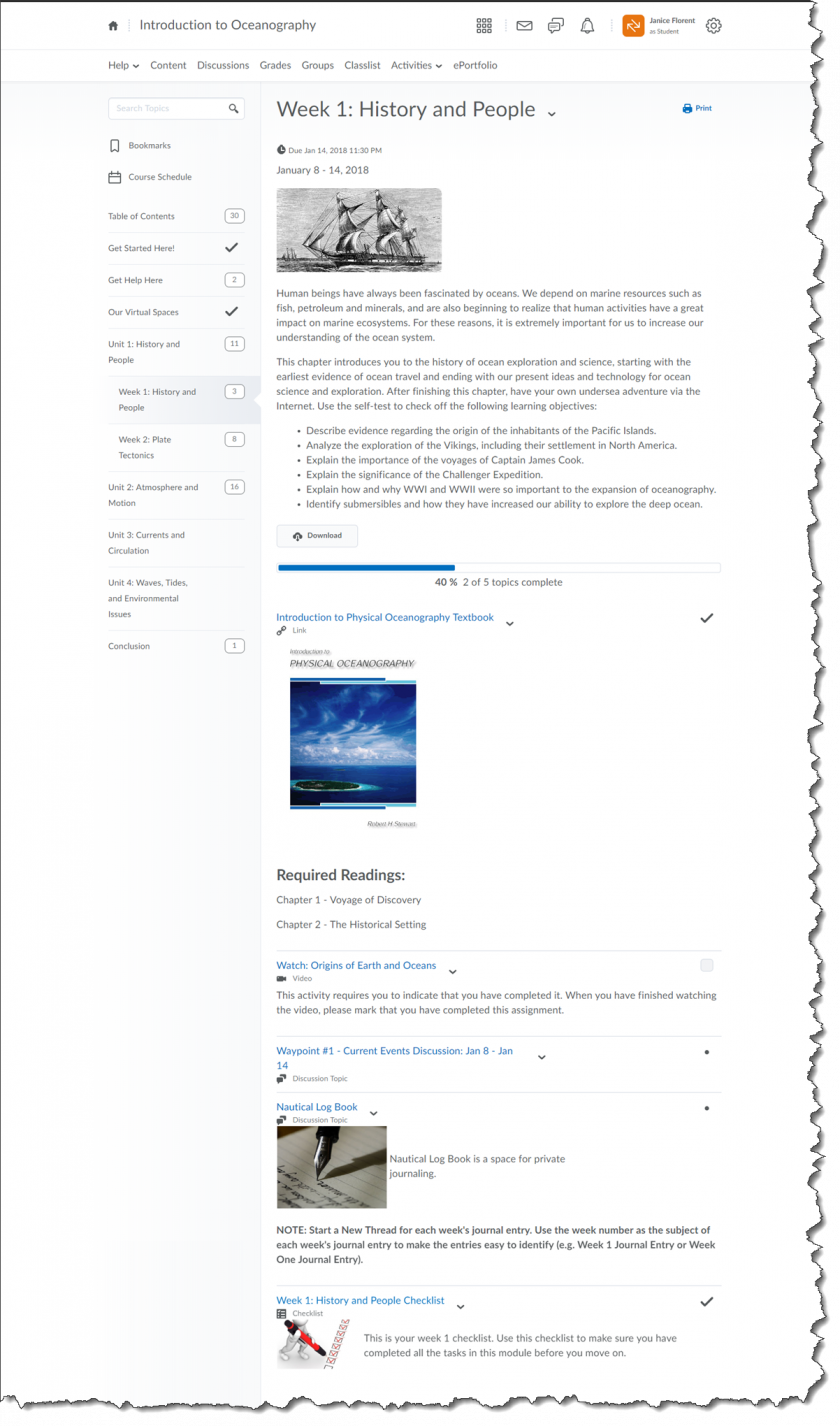Brightspace Assessment and Measurement Examples
Assessment and Measurement
Example 1 - Intro to Oceanography: Guidelines and Feedback
Clear guidelines and frequent and timely feedback is important to help students stay on track. The assignment details in this Introduction to Oceanography online course provide students with detailed information about their assignments as well as give them an expectation of when they can expect to receive feedback from the instructor on their assignments.
Example 2 - Intro to Oceanography: Weekly Module with Discussion Forum, Journal, and Checklist
The course content in this sample Introduction to Oceanography online course is organized by weeks. Everything that has to be accomplished for the week is in the module. For the assessments in this example, students contribute to a weekly current events discussion and are required to write a journal entry every week. The last topic in the module is a checklist. Students use the checklist to make sure they have completed all the tasks for the week.
Example 3 - Intro to Oceanography: Checklist and Quicklinks
Taking an online course requires students to be self-directed learners. Providing students with a checklist can help them to stay on track. This is an example of a weekly checklist in a sample Introduction to Oceanography online course. The checklist gives students an overview of the tasks they must accomplish for the week. Using Brightspace's Checklist tool makes it easy for the instructor to provide a quicklink to course content that is inside or outside of the course. Students can go directly to the content for the checklist item. Once they complete the task they can check it off the list. Each checklist item includes a due date. Students will see due dates when they look at entries in the course calendar. The due dates help students to stay on track.
Example 4 - Computer Based Information Systems: Weekly Module with To Do List, Reading Quiz, Assignment, and Exam
The course content in this sample Computer Based Information Systems online course is organized by weeks. Everything that has to be accomplished for the week is in the module. The module for the week starts with a list of tasks and the due date so that students know what they have to do each week. For the assessments in this example, students have to complete online reading quizzes, assignments, and a unit exam. Respondus LockDown Browser is used for the online exam in order to secure the testing environment.
Example 5 - Introduction to Public Health: Weekly Module with To Do List and Assignment
Clear guidelines and frequent and timely feedback is important to help students stay on track. The module for the week starts with a TO DO List so that students know what they have to do each week. The assignment details in this Introduction to Public Health online course provide students with detailed information about their assignment.
Example 6 - Introduction to Public Health: Interactive Rubric
Clear guidelines and frequent and timely feedback is important to help students stay on track. The instructor has attached interactive rubrics to the assignments in the Introduction to Public Health online course so that students can understand expectations and components of the assignments and are able to improve their work through timely and detailed feedback.
Example 7 - Music Appreciation: Interactive Rubric
Clear guidelines and frequent and timely feedback is important to help students stay on track. The instructor uses an interactive rubric to grade Concert Reports in a Music Appreciation course. The click and score simplicity of the rubric increases grading efficiency and enables the instructor to provide consistent evaluation and contextual feedback to the students.
Example 8 - Religion, Science, Universe, and Us: Coursework and Grade Distribution
Clear guidelines and frequent and timely feedback is important to help students stay on track. The coursework and grade distribution information in the syllabus for this Religion, Science, Universe, and Us (X-Core) course provides students with detailed information about their assignments, how they will be graded, and gives the students an expectation of when they can expect to receive feedback from the instructor on their coursework.
Example 9 - Religion, Science, Universe, and Us: Interactive Rubric
Clear guidelines and frequent and timely feedback is important to help students stay on track. The instructor uses interactive rubrics in this Religion, Science, Universe, and Us (X-Core) course to increase efficiency and provide consistent evaluation when grading. The benefit to students is they can understand expectations and components of the assignments and are able to improve their work through timely and detailed feedback.
Return to: Assessment and Measurement: See Brightspace Examples








